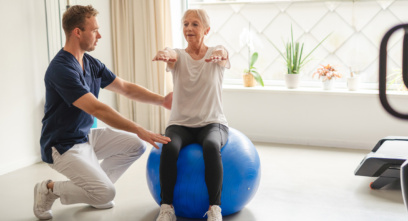Get the Best Treatment for Your Sciatica in Sydney With Benchmark Physio
Are you looking for sciatica treatment in Sydney? Benchmark Physio is a leading Sydney physio with 5 locations scattered across South-West and East Sydney in Earlwood, Revesby, Beverly Hills, Rosebery, and Rose Bay. With our years of experience and team of highly-trained physiotherapists, you can rest assured that you will get the best chance of relief from your sciatica with us. So, contact us today, and say goodbye to pain.





What is Sciatica?
It’s important to understand that sciatica is not a condition itself, but rather a symptom of an underlying condition. It refers to pain that radiates along the path of the sciatic nerve, which branches from your lower back through your hips and buttocks and down each leg. Typically, sciatica affects only one side of your body.
This pain is usually caused by compression or irritation of the sciatic nerve or the nerve roots in the lower spine. It is estimated that around 70-90% of the Australian population will experience back pain at some point in their life, with a further 5-10% of those cases experiencing sciatica. Read more in our blog on sciatica or see our top exercises for lower back pain.
The Symptoms
Sciatica symptoms usually occur on one side of the body and can range from mild to severe. They often start gradually and can worsen over time. Common symptoms include:
- Pain in the lower back
- Radiating pain down the hip and leg
- Numbness, tingling, or weakness in the legs and lower back
- Difficulty moving of the legs (severe)
- Loss of bowel or bladder control (severe)
The intensity of symptoms can vary, with some of our Sydney residents coming through the clinic experiencing infrequent, irritating pain, while others suffering from constant, debilitating pain. Regardless, it’s important to seek medical attention if you’re experiencing symptoms of sciatica. A healthcare professional can provide a diagnosis and guide you through appropriate treatment options. So contact us today if you need help with sciatica treatment in Sydney.
What Causes Sciatica?
Understanding the causes of sciatica is crucial to managing and finding relief from the condition. Common culprits include herniated discs, muscle spasms, spinal narrowing, degenerative disc disease, and even pregnancy. Most of these higher level causes occur through other means, such as:
- Improper lifting techniques
- Prolonged sitting
- High-impact activities
- Poor posture
- Obesity
- Age
- Pregnancy
Remember, if you have sciatica or are at risk, it’s important to consult a healthcare professional for a proper diagnosis and treatment plan. Some of our Sydney clients might benefit from exercises that strengthen the back muscles, improve flexibility, and promote proper posture.
Choose Benchmark Physio Today
At Benchmark Physiotherapy, we offer more than just sciatica treatment in Sydney. Our experienced physiotherapists provide comprehensive care aimed at treating the root cause of your pain. With convenient locations across South-West and East Sydney, we ensure easy access to effective treatment. Our approach is tailored, focusing on long-term wellness and prevention alongside immediate pain relief. Choose Benchmark Physio for a dedicated partner in your journey to a pain-free life. Contact us today.
Before undertaking any new exercise regimen, it is crucial to consult with a physiotherapist or healthcare professional. Each individual’s condition is unique, and personalised guidance ensures that exercises are suitable for your specific needs and health status.
FAQs
How Do You Cure Sciatica Permanently?
You can usually cure sciatica permanently without surgery. Your options include physical therapy for posture improvement and tailored exercises, stretching routines for lower back relief, regular gentle exercise like short walks, limited bed rest, and alternating hot and cold packs. Over-the-counter pain relievers and prescribed medications can also help. In severe cases, surgery might be necessary, with options like discectomy or laminectomy being considered if nonsurgical methods don’t provide relief after several months. However, it’s crucial to consult a healthcare professional for a personalised treatment plan.
How Long Does Sciatica Last?
Sciatica typically lasts around 4-6 weeks but can persist longer in more severe cases. Treatment is recommended as soon as you feel the symptoms of sciatica, as leaving it untreated can cause it to last longer. Fixing the underlying issue is crucial to reduce the risk of flair ups in the future.
How Do I Get Rid of Sciatica Pain Quickly?
When you feel sciatica pain, try applying cold or hot packs to the affected area as this can help reduce inflammation and alleviate the pressure on the sciatic nerve, decreasing pain. Maintaining good posture, avoiding prolonged sitting, and using supportive cushions can also provide relief. On top of this, gentle walks and light exercises can be very good for your sciatica, even if it hurts somewhat. Remember, these measures offer temporary relief and should be combined with targeted treatment via consultation with an experienced physiotherapist.
Does Sciatica Go Away By Itself?
Yes, often sciatica will go away by itself. But, it’s important to remember that sciatica is a symptom of deeper issues such as herniated discs, muscle spasms, spinal narrowing, degenerative disc disease, or even pregnancy. So while the pain itself might go away, if you do not address the underlying issue through regular appointments with your Sydney physio, then you increase the likelihood of a relapse.
Is Walking Good for Sciatica?
Absolutely! While it may be difficult if your pain is severe, walking is one of the best things you can do for your sciatica. The gentle movement helps reduce inflammation and pain, and standing keeps your spine in better alignment than sitting or lying down. It’s important to note that if you have severe pain, while walking might help, it’s important not to push past your limit. If it is too painful to walk for extended or even short periods of time, listen to your body and take it easy. But as soon as you are comfortable, it’s important to start moving again!


